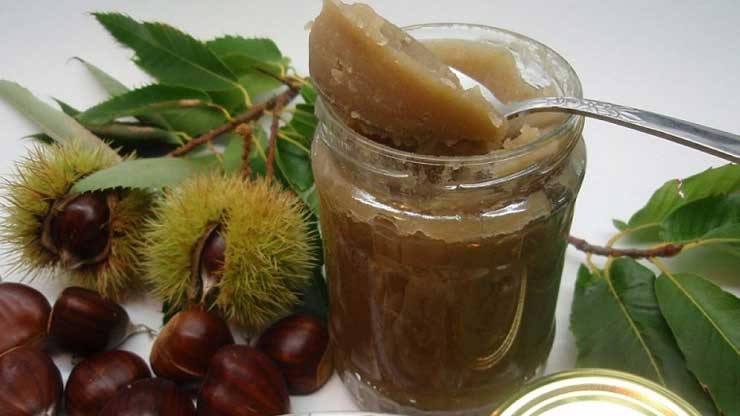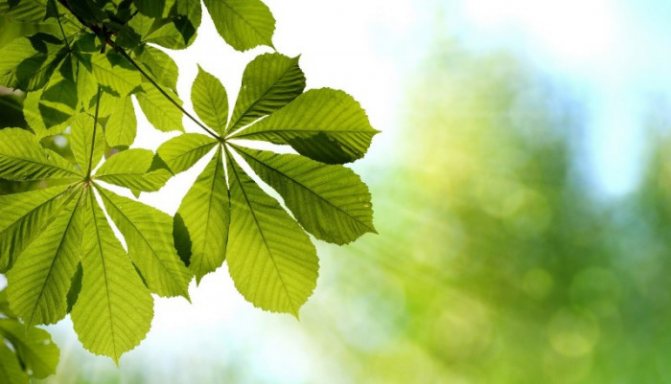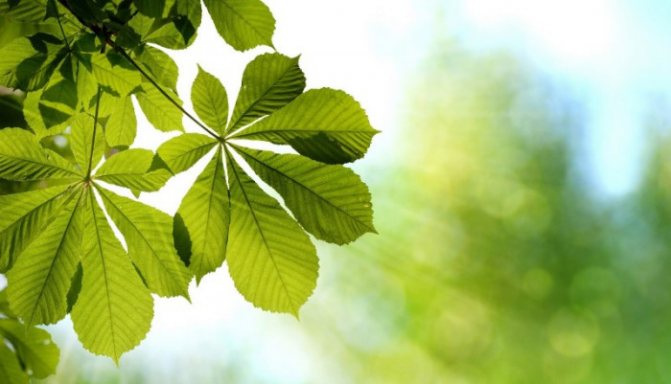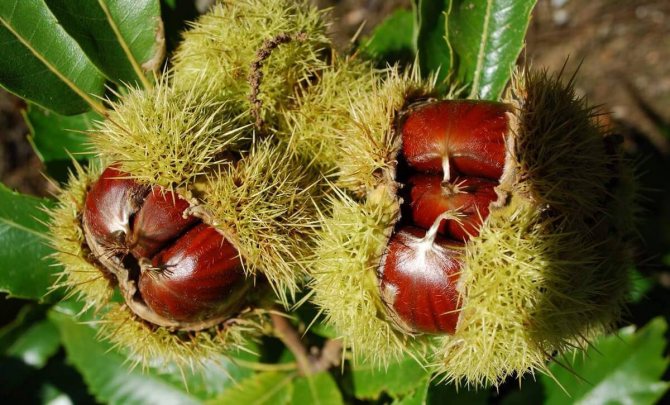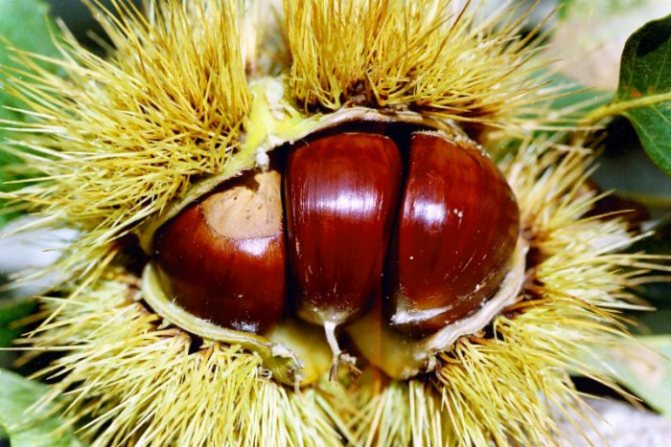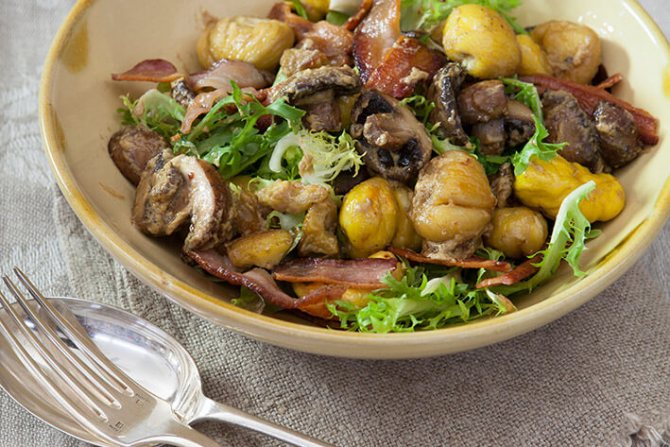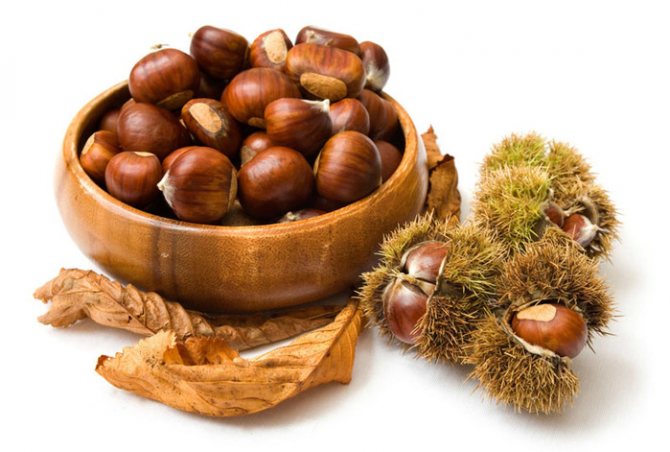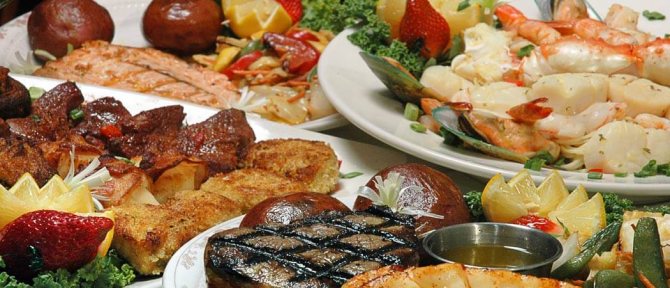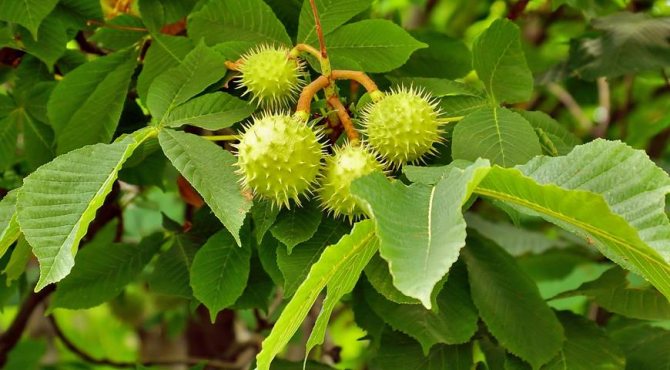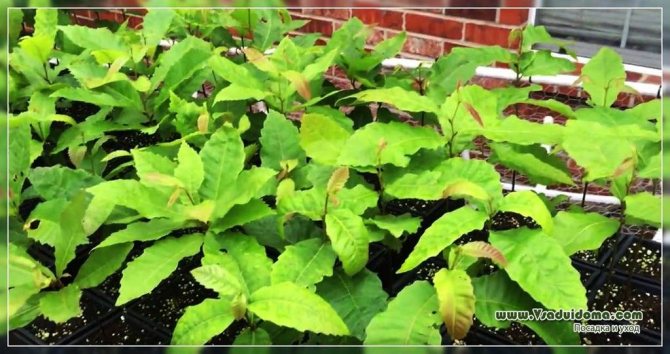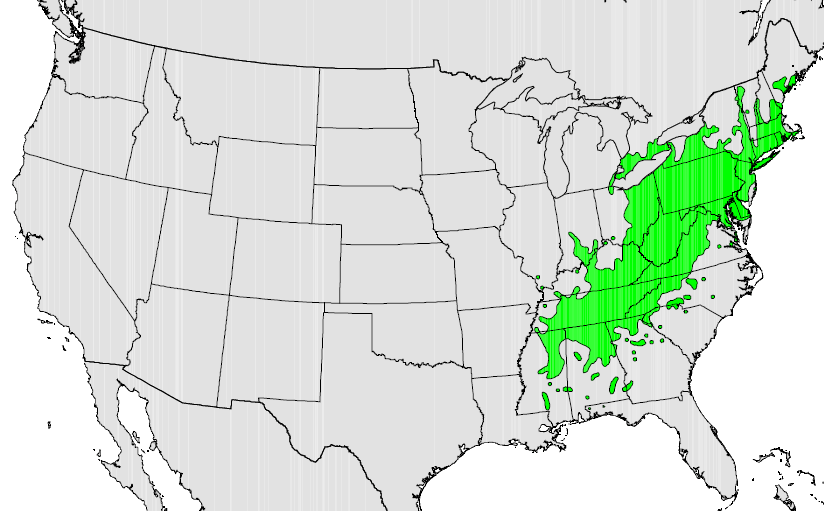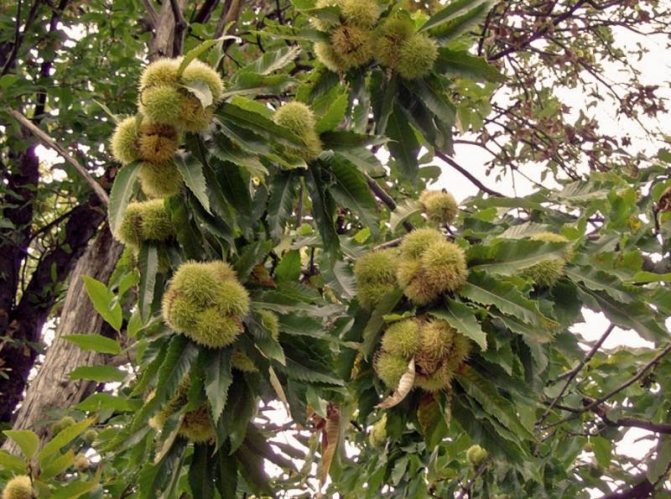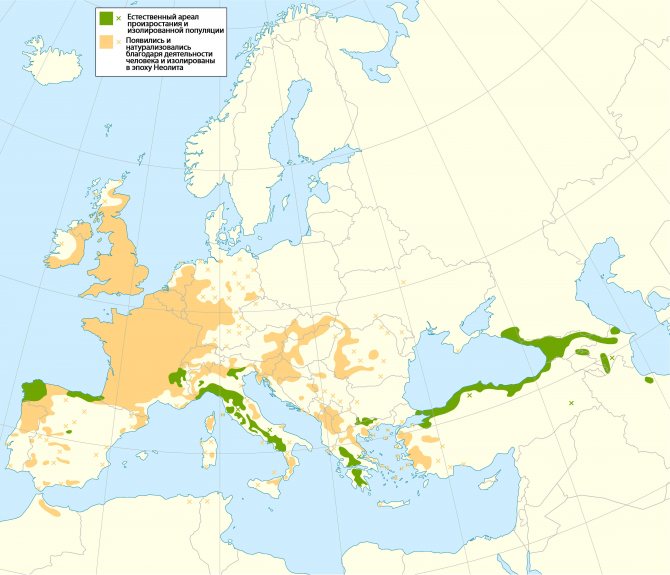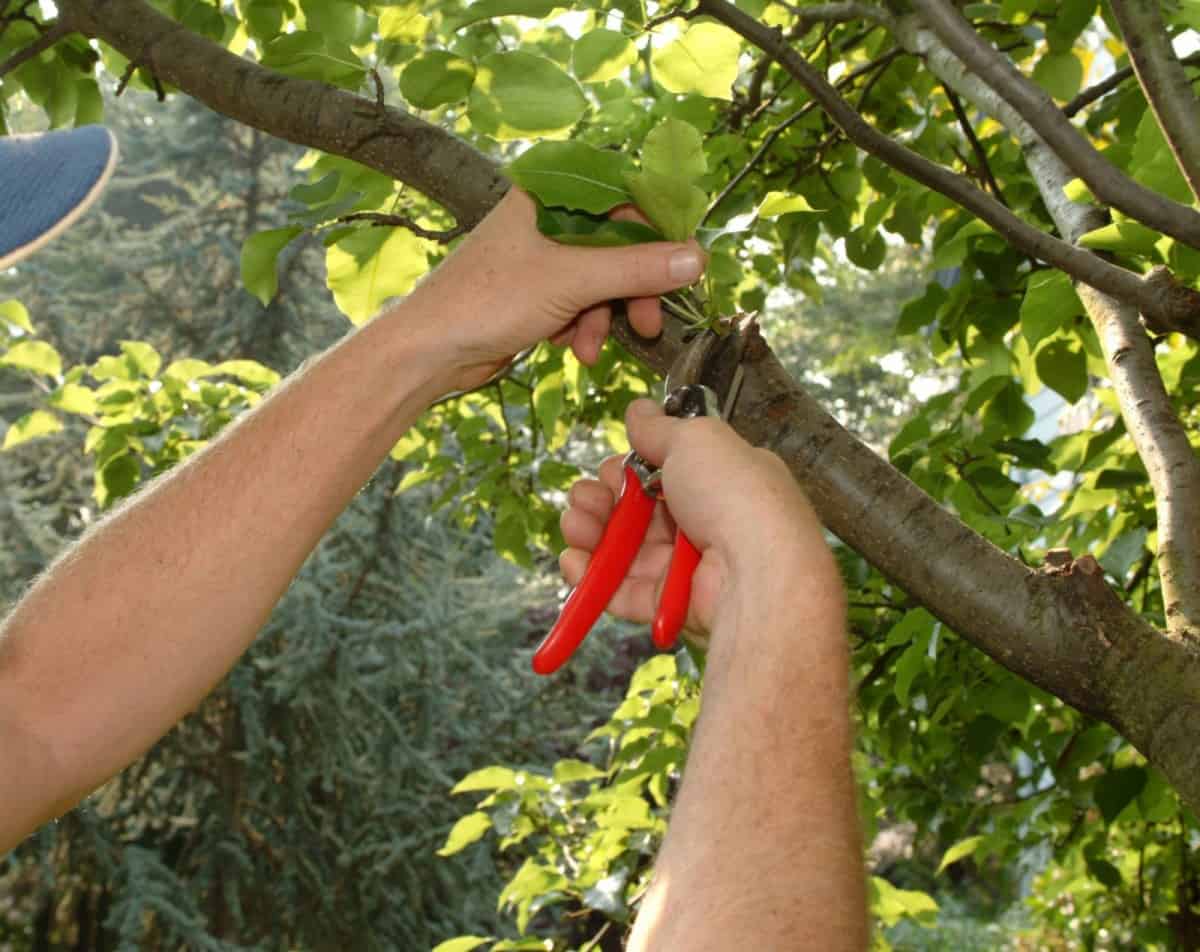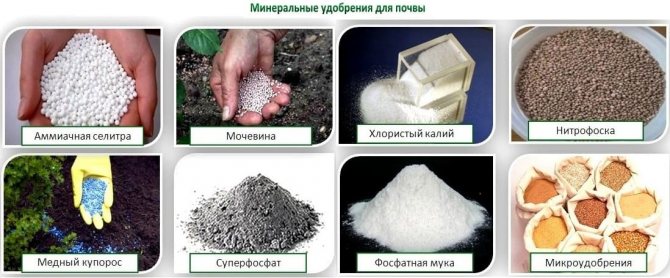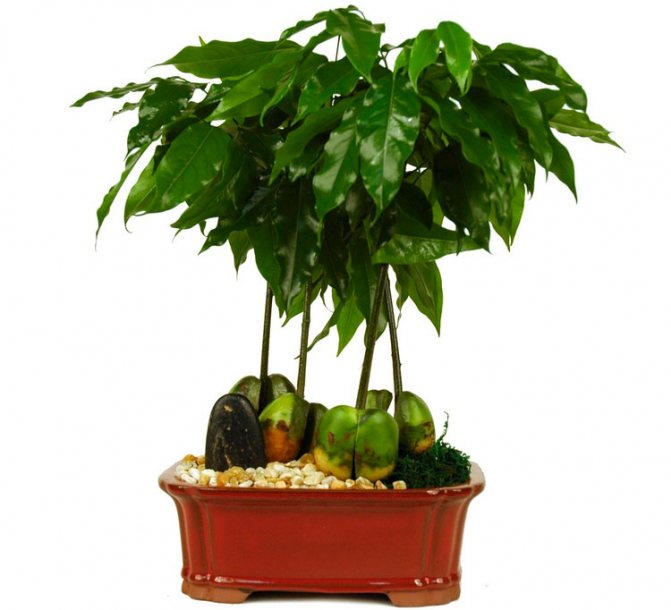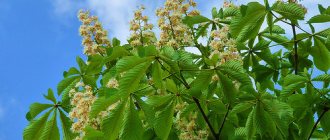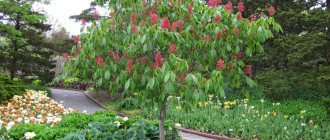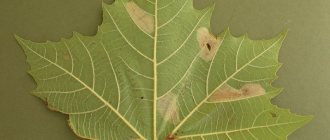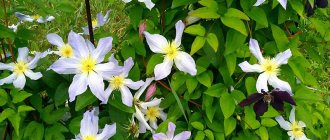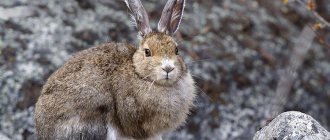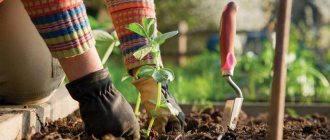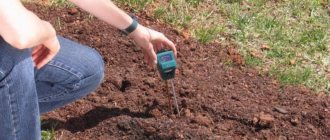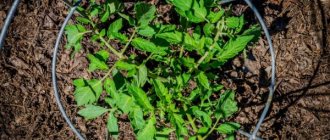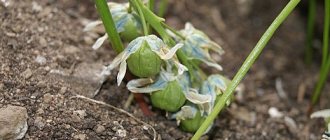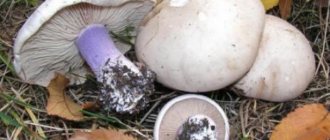How to grow an edible chestnut in the country in a bookmark 4
For lovers of beauty and a healthy lifestyle, I advise you to pay attention to the chestnut. Chestnut is a wonderful decorator of our gardens and an excellent healer for our souls and bodies. Why do I say that? Yes, because fifteen minutes spent under a chestnut tree may well charge you with vigor for the whole day, and its fruits are unusually beneficial for health. Tasty nuts of edible chestnuts are used to prepare a variety of dishes, and the inedible fruits of horse chestnuts have been used since ancient times in folk medicine.
Edible chestnut
To begin with, let's clarify that trees in parks and on city streets beautifully blooming with candles are horse chestnuts with inedible (but medicinal) fruits. In what follows, we will focus on the edible chestnut.
The height of the tree varies from 1 to 35 m, depending on the species and variety. It blooms very beautifully: pyramidal inflorescences will decorate the garden from late May to mid-July.
Chestnut nuts
Chestnut fruits are enclosed in cozy shells (each with 1 to 3 nuts), protected by thorns.
Chestnuts bloom and bear fruit beautifully in the gardens and parks of southern and central Russia. They prefer open, sunny locations.
Chestnut trees are bright individualists. No matter how hard you try, nothing will grow under them, because the chestnut creates a very thick shadow, and its powerful superficial roots prevent other crops from developing successfully. But this disadvantage can easily be turned into a virtue. You can install garden benches under the chestnut tree, where on hot summer days it will be nice to hide from the scorching rays of the sun.
"Two from the casket, but not the same from the face"
Everything is learned in comparison - a long-known truth. Therefore, a botanical description is indispensable. These differences are evident during the flowering period. It's almost impossible not to walk by and not admire the exquisite horse chestnut candles, that's what you can't say about the edible chestnut (below in the photo). At this time, he looks more like a willow or a shaggy polar bear. But all the same, its crown has an unmatched appearance. Now it's worth considering each feature separately:
- Height. They can reach 35 to 50 meters in height, almost like a 14- or 20-storey building. But their "brothers" are never higher than 25 m.
- Fetus. Differs in increased "shaggy", because it is densely covered with thin elastic needles. Behind this "fur coat" is hidden from one to three flattened nuts, the mass of which is no more than 20 g. From one tree, you can collect up to 190 kg of the crop.
- Leaves. They do not look like the cone-shaped foliage of a horse-like kind gathered in luxurious fans. Each leaf of the edible chestnut tree is planted with short rather than long petioles. Its deciduous plate has an oblong-oval shape, 22 cm long and up to 7 cm wide.
- Inflorescences. These perennial plants bloom in the first half of summer - in June, and sometimes in July. Flowering is presented in the form of thin 15-centimeter ears, in contrast to the pyramidal brushes of its "relative".
Peeling nuts can be very difficult to remove. Therefore, some people practice soaking them in water for several hours.
You can collect the fruits of these representatives of the Beech family in the fall (October or November). While on the stomach, they ripen by September 1. It is worth remembering that an edible chestnut tree begins to bear fruit after 20 years after planting.This is five years later than other varieties. But in order to successfully grow these specimens in the country, you need to know their natural habitat.
Planting chestnuts
When planting, keep in mind that a place of at least 3 m (or even more) in diameter should be allocated for each seedling. Only in this case, an adult tree will delight you with a spreading crown, abundant flowering and good fruiting. Chestnut prefers loamy leached chernozem. It is immune to winds, air pollution and is quite frost-resistant.
Planting chestnut seedlings
It is most convenient to plant chestnuts with 1-2-year-old seedlings. To do this, prepare square pits 50x50x50 cm in size. Mix the ground removed from the pits with humus and sand in the ratio: 2: 1: 1 and add 0.5 kg of dolomite flour and slaked lime; pour 200 g of nitrogen-phosphorus-potassium fertilizer into each hole. At the bottom of the holes, lay a drainage layer (pebbles or crushed stone, mixed with sand) of 10-15 cm.Then sprinkle it a little with soil substrate, spill the hole well with water, place a seedling in it and carefully fill the hole with soil, tamping it slightly with your hands.
When planting large chestnuts, place the root collar of the seedling 8-10 cm above the level of the planting mound. Seedlings of low and medium-sized varieties of chestnut do not need to be overestimated. Attach the seedlings to a support to avoid damage during strong winds. After planting, water the plant abundantly with warm water.
Planting chestnut seeds (in autumn)
Chestnut seeds (nuts) germinate well in the open field even without our intervention. Collect the fallen nuts in the fall and carry out the stratification procedure (cold aging). To do this, put the nuts in an open box, sprinkle with sand and refrigerate or in the basement for 10-12 days. Optimum temperature for stratification: + 5 ... + 6 ° С. Then you can place the seeds in open ground.
Loosen and spill the soil well with water, bury the nuts 5-6 cm at a distance of 10-15 cm from each other, then fill them with fallen leaves (no need to bury). That's all - the chestnut seeds are ready for wintering, and in the spring you will see green shoots, and all you have to do is thin out the seedlings, leaving the most powerful plants.
Planting chestnut seeds (in spring)
Fruits fallen in autumn should be covered with sand and stored all winter at a temperature of + 5 ... + 6 ° C, and before planting in open ground for 5 days, place them in warm water. Then plant chestnut seeds in your favorite spot in the country. With such cultivation, one-year-old chestnuts will grow by 20-25 cm in a year, and at the age of five they grow up to 3 m in height.
Sowing seedlings in pots
I put the hatched nuts in prepared pots with moistened earth. I had very little soil available, and there should be no pulling with the landing. Therefore, the cups are tiny. Ideally, 0.5 liter containers would be suitable. This is important: we put the nuts in a sprout at the bottom.
The landing should not be deepened. I sprinkle the chestnuts with a small amount of soil, water them and put them on the windowsill. It is recommended to trim the tip of the sprout with a sharp blade, followed by disinfection of the cut. I myself did not perform such an operation, since I do not find it particularly necessary. All further care consists in timely watering. If you fill the planting, the seed will rot. With a lack of moisture, it will dry out. After another week, a powerful sprout will appear (to match the nut).
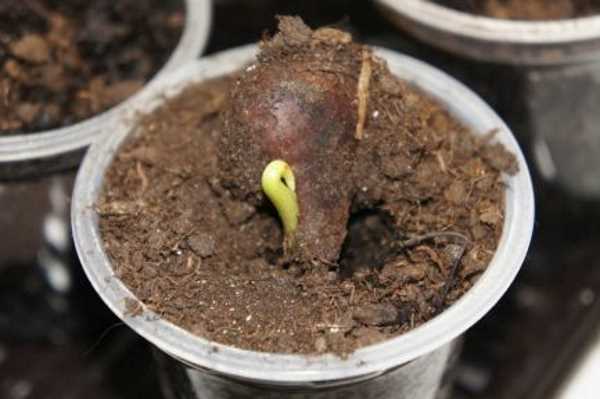
Do not rush to throw away the planting if you have not seen an escape after 2-3 weeks. For me personally, one nut came up in a month. Of the 20 chestnuts I have planted, 16 have grown. Seedlings need a lot of light.
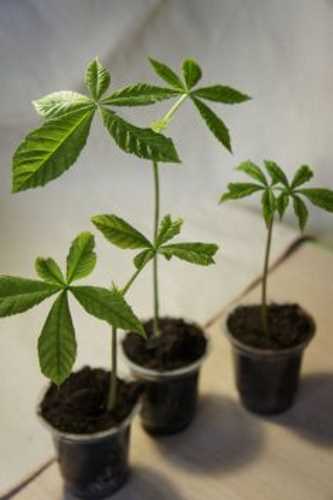

You can start hardening the plants a couple of weeks before planting on the site, taking them out to the open balcony. First year chestnuts should be planted in a makeshift nursery. It will be a corner of the garden, protected from wind and scorching sun.Plant two-year-olds in a permanent place next spring.
Types of edible chestnuts
In nature, there are just over 30 species of chestnut trees and shrubs. Here are several types of chestnut trees, the fruits of which are eaten.
European sowing chestnut
Sowing chestnut is a noble slender tree up to 35 m high with a regular ovoid crown. Leaves are large lanceolate, 25-30 cm long. Inflorescences are spike-shaped, light yellow in color. Nuts are large, enclosed in a round fluffy cocoon. Sowing chestnut is a long-liver, under favorable conditions it can live in one place for up to 500 years, and in natural conditions even longer.
Sowing chestnut
Chinese chestnut is the softest
The softest Chinese chestnut is a beautiful tree up to 15 m high, with spreading branches and finely toothed leaves. Chinese chestnuts are famous for their unsurpassed taste.
Chinese chestnut is the softest, photo from the site
Japanese chestnut, or crenate
Originally from Japan, China and Korea. It grows quickly and begins to bear fruit early (2-4 years after planting). The fruits are the largest among edible chestnuts, up to 6 cm in diameter and up to 80 g in weight. More than 100 varieties with tasty large nuts have been developed in Japan.
Japanese chestnut (crenate)
Among summer residents-gardeners, horse chestnut is more valued for its decorative qualities. Its luxurious crown, strewn with lush candlesticks of inflorescences, is simply breathtaking, and you want to admire this magnificent creation of nature again and again.
Do chestnuts grow in your country house?
Meeting place can not be Changed
Representatives of the Sapindovy family need loose and fertile soil. Moderate climatic conditions have a beneficial effect on their growth and development. They are often found in the south of Europe and Russia, as well as in northern India, in eastern Asia, in China, Canada and the countries of North America. However, edible chestnuts grow mostly where the climate is more humid. Most often these are subtropical latitudes:
- Mediterranean (Italy, France, Spain);
- Asia Minor (Caucasus);
- Russian Federation;
- European part of Eurasia;
- U.S.A.
Moreover, this species survives well in temperate climates. Therefore, it is grown to decorate some national parks and mass recreation sites. In addition, edible chestnuts, the benefits of which were known many centuries ago, are widely used in cooking by many peoples. The beneficial properties of the fruits, flowers, leaves and bark of this plant encourage gardeners to replenish their land with this variety.
For them, sudden changes in temperature are destructive. The scorching rays of the sun, as well as the stuffy air, dry out the leaves, leaving burns on them. Severe and prolonged frosts destroy the shoots / roots of the tree.
It's time to grow edible chestnuts today
Until recently, few people heard about chestnuts in the Middle Lane, today gardeners are actively promoting them after walnuts. The topic will be important to everyone who wants to grow their walnut garden with the maximum variety of species and varieties, bringing more and more winter-hardy exotics there.
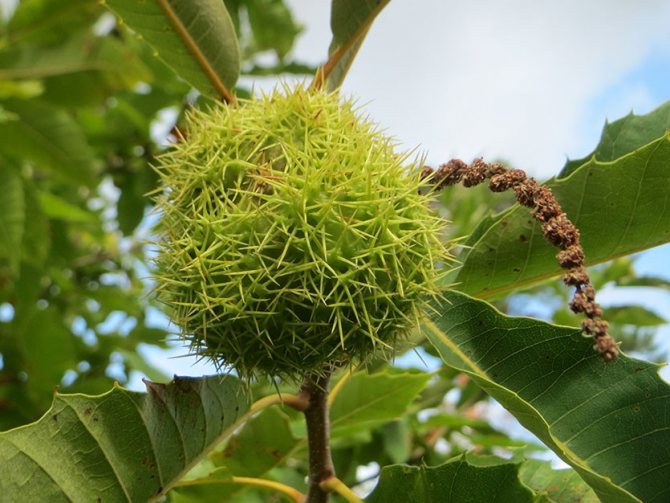

Andreas Rockstein /
Growing conditions. Different types of edible chestnuts have different winter hardiness. Usually, the American toothed chestnut (up to -35 ° C) can withstand the most severe frosts, then the softest Chinese chestnut (-30 ° C), the European noble chestnut of Caucasian origin endures up to -29 ° C, the Japanese crenate chestnut to -26 ° C, dwarf chestnut down to -25 ° C. Planting has a great influence - it should be a bright corner without a draft, with fertile moderately moist soils, where water does not stagnate. Better not even full sun, but partial shade, tk. chestnuts prefer high humidity. On dry soils, chestnuts need to be watered frequently, at a young age at least once a week, and even more often in hot weather.On dense clayey soils, the chestnut must be planted on a hill, on the southern slope. The best soils will be fertile sandy loam with slightly acidic or neutral pH 6-7. The European chestnut prefers calcareous soils and is the most drought-resistant, the Japanese chestnut categorically avoids such soils and likes frequent rains (more than 1000 mm of precipitation / year). American and Chinese species occupy an average position in terms of precipitation and soil acidity. Sooner or later, all chestnuts are attacked by fungal infections (like aspen), which leads to a hollow trunk, but the tree usually does not die. If the soils are waterlogged, this leads to the early aging of the tree, and in winter such soils freeze harder. The hollowness of the trunk of the less resistant American toothed chestnut begins already at the age of 60-70 years, and after 100 years, almost all trees are not suitable for commercial timber. Although this is definitely a plus for swarming forest bees. In addition, chestnuts often form large ecosystems, forming symbiosis with fungi (mycorrhiza), plants and animals. The neighbors of chestnuts in nature are oaks, beeches, hornbeams, ash, alder, fir and other conifers, it is these species that are best used when creating a forest garden.
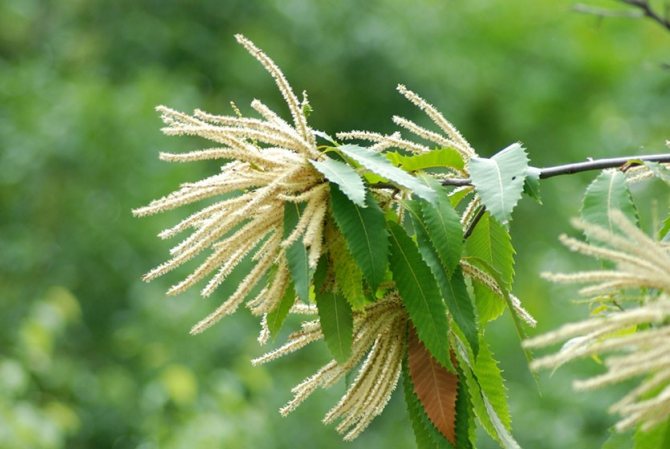

BobMacInnes /
Planting and leaving. Growing chestnuts from seeds in the Middle Lane is fraught with some difficulties. After ripening in October - November, when stored in a dry place until spring, the nuts dry out and greatly lose their germination; when stored in a damp substrate, even with moss, they begin to rot after 2 months. The seeds do not particularly need stratification, they only need a dormant period of 1.5 months, after which they begin to germinate (at high air humidity, germinating even without immersion in the ground). And in the Middle Lane this happens in January, when there is a strong lack of sunlight, due to which the seedlings are quickly stretched out, the trunk is formed thin and is more susceptible to drying in summer and freezing in winter. Moreover, it is necessary to plant the nuts immediately in a very deep container (more than 30 cm), which will ensure the vertical growth of the taproot. If the root twists, it will soon rot. The nut should not be immersed in the ground completely, but so that the shell is visible above the ground. Even in nature, germination occurs only after a good warming up of the earth, at the end of May - June. At home, at a temperature of + 25 ° C, chestnuts germinate actively. A containerized seedling is best planted in the first year in June. Having prepared deep holes 50 × 70 cm, which will ensure good survival and growth in the first years of life. The hole must be filled with fertility (preferably black soil or sapropel), sand and local soil in a ratio of 2: 1: 1. If the local soil is sandy, then replace the sand with loam. Immediately, the seedling must be well watered and mulched. Feeding it annually with organic matter at the beginning of summer, peat crumbs in the middle, and ash at the end of summer, you can achieve impressive growth results - 50 cm per year. It is important to water the seedling every week (or densely mulch with straw), on dry soil growth is greatly slowed down. For the winter, the chestnut is well mulched, and when the daytime frost sets in, the trunk is wrapped with agrofibre. Moreover, for seedlings less than a meter high, it is better to make a frame shelter.
Do you like the video? Subscribe to our YouTube channel and become professional gardeners with Prosvetk!
The most dangerous parasite for chestnuts is the fungus Endotia parasitica, which has wiped out virtually all chestnut forests in America since the introduction of the Chinese species. Asian species (Japanese, Chinese, Henry, Shogyu) have sufficient immunity to this disease, European and dwarf chestnuts show weaker immunity and resistance to the parasite, but the American toothed chestnut turned out to be absolutely vulnerable, despite all its hardened to frost and air pollution ...Therefore, today work is underway on the crossing and breeding of varieties of cultivated large-fruited chestnuts, the most resistant to both infectious and climatic factors. And already in this century, gardeners of the Middle Lane will not have 2-5 types of nut crops in their area, but 2-3 dozen species (nuts, hickory, chestnuts, hazelnuts, almonds, cedars, etc.).
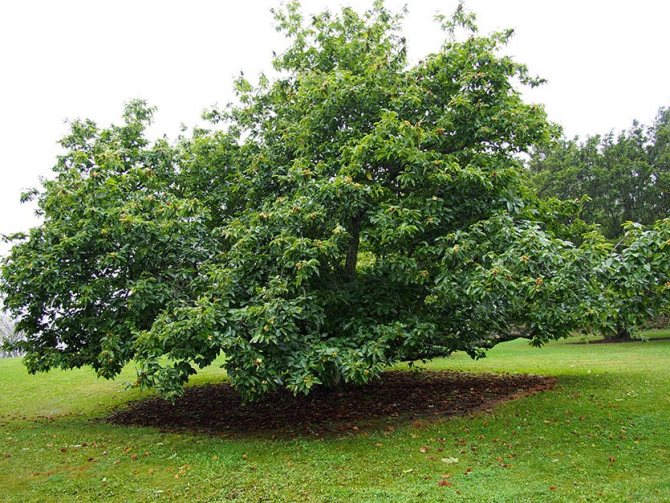

Distribution and habitat
It grows in a humid and warm subtropical climate, where at least 1000 mm of precipitation falls per year.
In the Caucasus, mainly in the Western Transcaucasia, it forms dense forests on shaded mountain slopes with acidic brown loamy soils at an altitude of 300 to 1200 m above sea level. At an altitude of more than 1000 m, it often grows with fir, below it is mixed with beech and hornbeam forests.
The total area of chestnut forests in the USSR was more than 50 thousand hectares; about the same area, chestnut was found as an admixture in forests from other species.
Propagated by seeds and tree stumps. The fruits germinate well. The seedlings are quite shade-tolerant.
It grows quickly, develops a powerful root system, therefore it is resistant to windfall. The 1000-year-old chestnut trees are known. Lives in forests for 100-150 years. Begins to bear fruit in plantations from 20-25 years. A high yield of fruits occurs every few years.
How to grow an edible chestnut in the country
Roasted chestnuts are the hallmark of a bustling eastern anthill called Istanbul. But nothing prevents you from turning the edible chestnut into your culinary trump card. Buying the corresponding product in our country, of course, is very difficult. But after all, instead of running around the shops, you can always plant an edible chestnut in your backyard and harvest from the tree every year.
The main plus of the edible chestnut for domestic gardeners is that it is not afraid of frost at all. The tree can grow in megacities and near highways. That is, even where the gas content of the atmosphere reaches a very high rate. When choosing a place for a seedling, keep in mind: the diameter of the beds must be at least 300 cm. Otherwise, the plant will be too crowded. This will result in poor flowering and low fruiting. But you want to feed all your family and friends with homemade chestnuts!
Edible chestnut and its horse namesake are not brothers or even relatives. You will be surprised, but these types of trees belong to different families. The first - to the Bukovy family. And the second, with which alleys and parks in domestic cities are planted, - to the Konskokashtanovs. When starting to grow edible chestnut in your country house, you need to understand this difference.
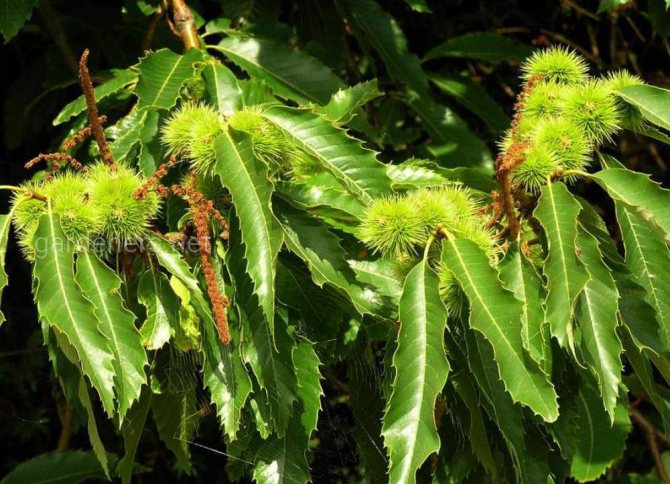

Planting chestnut seedlings
Leached loamy black soil is considered the ideal soil for edible chestnut. If you decide to propagate the plant with seedlings, give preference to the planting material at the age of one to two years. Younger seedlings take root less well in the open field.
Landing algorithm
- We form planting holes with a depth of 50 cm each. The shape of the pit should be square with a width and length similar to the depth.
- We mix the earth that we got from the pit with humus and river sand as follows: we take one part of the indicated additives for two parts of the soil.
- Add a pound of dolomite flour to each portion of soil.
- As an additive, we use 0.5 kg of slaked lime
- We mix river sand with sea pebbles and spread it on the bottom of the planting pit, thus forming a drainage with a height of 0.15 m.
- Add a small amount of prepared soil on top of the drainage to form an intermediate layer of about 5-7 cm.
- Water the drainage and the primary soil layer from the watering can.
- We install a seedling in the hole and fill it with the prepared substrate, slightly slapping the ground from above to tamp the contents of the earthen hole.
- We form a mound above the tree, which is 10 cm above the ground line.
- We install a special support next to the seedling and attach a young tree to it in order to protect it from the negative effects of atmospheric phenomena.
- Water the young plant abundantly from a watering can with water well warmed up in the sun.
Before planting, in the process of preparing the soil substrate, it is worth adding a complex fertilizer based on nitrogen, potassium and phosphorus to the soil at the rate of 0.2 kg per well.
Planting chestnut seeds in the fall
Chestnut seeds are called nuts. They can be planted both in the autumn season and in the spring - after the awakening of nature from hibernation. Note that chestnut nuts can easily sprout without human intervention.
Landing algorithm
- In the autumn, we collect chestnuts and stratify them: we pack them in a canvas bag and put them on the refrigerator door for two weeks. If this is not possible, we mix the nuts with river sand in a cardboard box without a lid and send them to the basement for two weeks.
- After two weeks, we form rows in the open field.
- Sprinkle them abundantly with water from a watering can.
- We deepen the planting material by 5 cm into the ground, keeping a distance of 15-20 cm from each other.
- Sprinkle the planting material with fallen leaves (and not earth, as many believe!).
- With the arrival of spring, we find that the nuts overwintered well and gave green shoots.
- We thin out the resulting seedlings, removing weak representatives and leaving strong and strong specimens.
Scientifically, chestnut is the fruit of the stomach or horse chestnut. In the first, it is poisonous. The second is inedible. The fruits of the edible chestnut are correctly called nuts.
Planting chestnut seeds in spring
Nuts stored in the fall for spring planting also need to be stratified. The best way is to mix them with sand and put them in a cardboard box in the lower compartment of the refrigerator, away from the freezer. In this form, the nuts should spend the whole winter. The subsequent sequence of actions is described below.
Landing algorithm
- We form grooves.
- Water them abundantly.
- We spread the nuts at a distance of 15 cm from each other.
- Sprinkle with earth.
- A year later, we observe how yesterday's chestnut turns into a 30-centimeter tree.
In order for the nut to be completely ready for planting in open ground, a week before planting it must be placed in water at room temperature. This will allow the shell to swell, and the embryo inside will finally form.
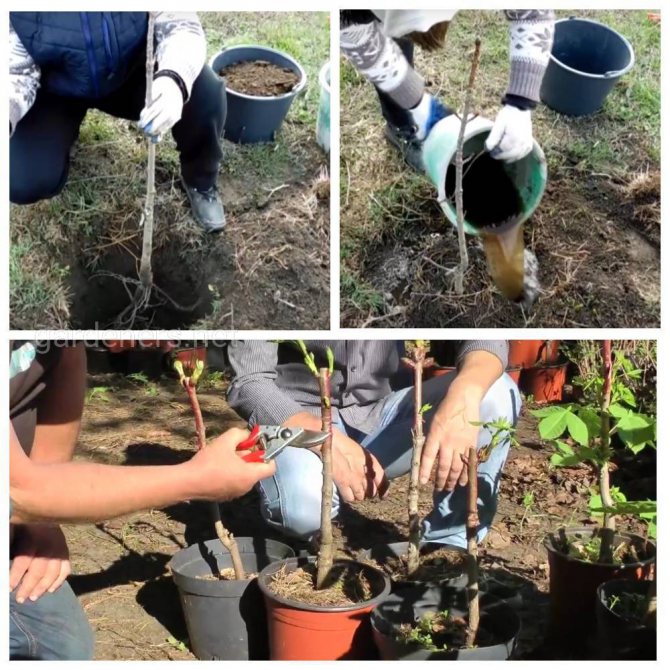

How to plant a chestnut at home. How to plant walnut chestnuts in a pot
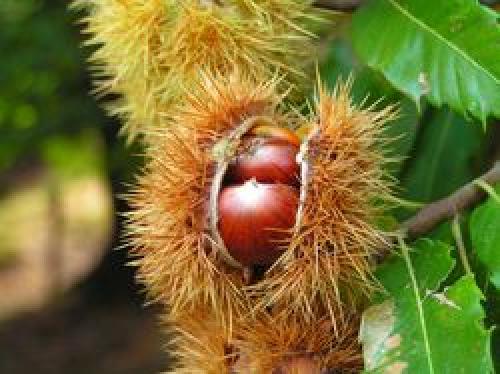

Chestnut
Chestnut is one of the most beautiful plants on earth. Many people dream of having such splendor at home. However, buying a chestnut seedling is expensive. To save money, you can resort to the method of growing the plant at home. To do this, you need to properly plant walnut chestnuts. According to experts, a lot of work is not needed for this, and you can do without buying special equipment.
How to prepare a nut
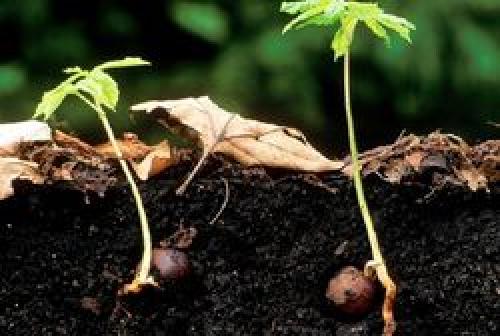

Potted chestnut
It is best to take nuts for subsequent planting from a tree that has a strong and massive trunk. It is better not to pluck the fruit, but to take the one that has fallen off on its own. This is justified by the fact that such a nut is fully ripe for growing a new tree. Before planting an edible chestnut, you need to do some preparatory work at home with it. Stratification is the name of the process of preparing a nut for planting. The time of the preparatory work directly depends on the time of year when it will be possible to plant the nut. As a rule, it is spring or autumn. The cottage will be an ideal place for breeding chestnuts.
If autumn is the time of the year when the nut will be planted, then keep it in a place with a high level of coolness for no more than 10 days. The chestnut should be placed in sand with high humidity and left to infuse in the basement of the house or in the refrigerator.
Spring is recognized as a more convenient time of the year to start sowing. As for the chestnut, the edible fruit must be well preserved before being planted in the spring.
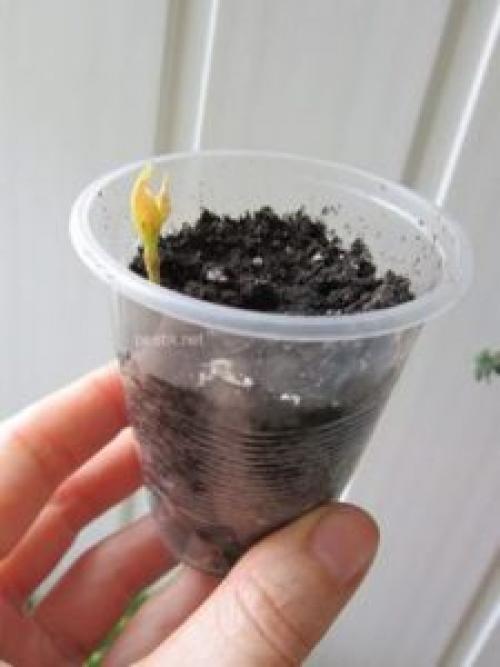

Sprouted chestnut
As a rule, it is saved in two ways:
- Plant walnut chestnuts at home. During the winter period, the chestnut should dry out a little, but not completely dry out. This should be closely monitored, since a chestnut that dries up will not be able to sprout in the future for growing a tree. To prevent this from happening, it is necessary to provide the nut with a comfortable place for drying. As a rule, a basement or a cold store is used for this.
- Street method (dacha). It implies the safety of the fallen chestnut at the roots of the native tree. To do this, cover it with sand and cover it tightly with leaves. The chestnut should be there until spring comes. Then it is taken out and transplanted into a pot.
How to plant correctly
The nut must be softened before planting. To do this, it is placed in a container with hot water. For a week, he must stay in the water at home. However, do not forget that the water temperature should not drop too low. As soon as white sprouts begin to appear on the fruit, this will be the main sign that the nut is ready for planting.
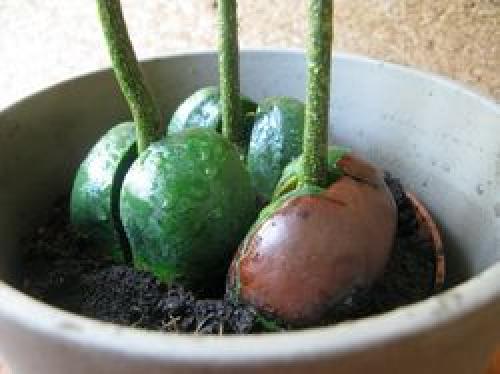

Planted chestnut
It is best to plant a chestnut nut at home on a dirt surface. For seedlings, create favorable conditions for germination using wood or plastic. It is from them that the pot is made. It would be more correct to plant a chestnut in a large pot. In such a container, it is more convenient for the roots of a young chestnut to grow at home. It is important to know that the chestnut nut should be properly planted in the ground to a depth that will exceed its own length at least three times.
The edible chestnut will bear high quality fruit if planted in spring. According to experts, this spring is considered the ideal time of the year to plant edible walnut chestnuts. If the chestnut is endowed with a decorative function, then it is preferable to plant it during the sowing period, when autumn comes. This is due to the fact that during the winter in the ground the seedling will get stronger and will be able to withstand different weather conditions.
How to care for a tree
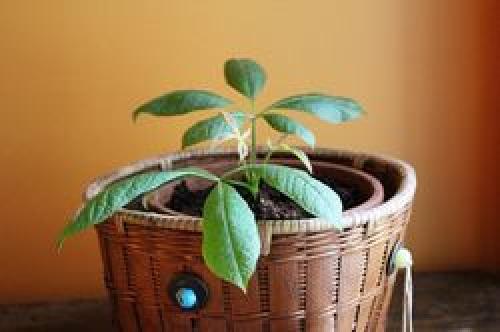

Small chestnut
After the chestnut seedlings have sprouted, it is better to transplant them into a large pot and bring them into the house. At home, it is best for him to stay for the entire winter-spring period. During this extended period of time, do not forget to take care of the plants. Chestnut loves moisture, so it should be watered often and tightly. Also, infrequent feeding of the plant with useful fertilizers will not be superfluous.
After the end of the frost period in the spring, you can safely transfer the seedlings from home conditions to the street. An ideal day for transplanting a seedling would be a cloudy day. However, it is worth paying attention to the fact that the chestnut cannot be immediately pulled out of the pot and planted in the ground. A young tree must first be taught to live in outdoor conditions. To do this, the seedling should be taken out into the street for several hours, gradually increasing the time.
After that, the seedling is moved to open ground and tied to a support. Chestnut is considered an unpretentious plant. The only thing he loves is water, so you need to water it often and a lot.
It is important to know that a chestnut tree that has been growing for more than 10 years does not require care. Until this age, it is still worth watching him. Frequent watering, complementary feeding with fertilizers, cleaning of dried up branches are the most necessary conditions for care.
Varieties of edible chestnut
There are about three dozen varieties of edible chestnut, the nuts of which can really be eaten. We will tell only about the most popular varieties, one of which you, in pursuit of culinary goals, can plant in the country or near the house.
Sowing chestnut
- Maximum height: 35 m
- Features of nuts: large, placed in a fluffy shell
The second name of the edible seed nut is European. This representative of the flora can grow in one place for up to five centuries. This means that the tree planted by you will see not only your great-grandchildren, but also more distant descendants. The large lanceolate leaves of this plant reach a length of 30 cm. The crown is beautiful, lush, and resembles an egg in shape.
The chestnut fruit contains a huge amount of nutrients. Therefore, it is not surprising that 40% of the world harvest of nuts is eaten by the inhabitants of the Celestial Empire.
Chinese softest chestnut
- Maximum height: 15 m
- Features of nuts: delicious
The nuts of the softest Chinese chestnut are a delicacy of pure water. They, like Piedmont truffles, are famous for their excellent taste characteristics. The leaves of this chestnut are of the fine-toothed type. The branches are located quite wide, which is why an adult tree grows sprawling and voluminous. On the reverse side, the foliage of the plant is covered with fine whitish pile. The inflorescences of a representative of the flora are located vertically relative to the ground and can be not only white, but also pink, yellowish and others.
Chinese chestnut has a higher calorie content than its European counterpart. 100 g of Chinese chestnut fruit contains 224 kcal.
Japanese chestnut
- Maximum height: 15 m
- Features of nuts: the largest of its kind (up to 80 g)
The second name of the chestnut is crenate. The plant has an intensive development schedule and begins to bear fruit at the age of two to four years. The nuts of the crenate chestnut differ from the fruits of its fellows in their large size and are considered the largest among all the edible chestnut varieties. This type of edible nut grows in Japan and Korea, but is cultivated in many other parts of the world.
In terms of vitamin and mineral composition, edible chestnuts are similar to brown rice.
Edible chestnut, according to archaeologists and historians, people have eaten since ancient times. Chestnut bolls in ash were found during excavations in different parts of Eurasia. This suggests that in those distant times, edible chestnuts grew almost throughout the continent. The current situation is fundamentally different from the past state of things. However, you and I have something more valuable - the opportunity to grow a chestnut with our own hands in order to enjoy what has matured under the careful guidance of a person.
Economic value and use
In France, banon cheese is traditionally wrapped in chestnut leaves. The leaves give the cheese tannins and essential oils that keep the cheese moist and develop its flavor and aroma
The chestnut nut is very nutritious. In Corsica, it is an important food product. Flour is made from it, eaten raw, baked and boiled, it is dried, smoked, various dishes are prepared, used in the preparation of cakes, pastries, ice cream, sweets and other confectionery products. Chestnuts contain almost 6% protein, up to 60% starch, about 15% sugars, more than 2% fat, and little fiber. The average yield of one adult chestnut tree is 100-200 kg. The average fruit yield in the chestnut forest is up to 1 t / ha. Fruits on different trees differ in weight, shape, taste, and chemical composition. Dried nuts are used as a coffee substitute.
In Russia, it grows on the Black Sea coast of the Caucasus from Dzhubga to Sochi, especially in the Tuapse region. According to legend, it was brought to the Caucasus by the ancient Greeks, who founded many colonies on the Black Sea coast. For a thousand years, the chestnut has gone wild and entered the local ecosystem. Many animals, plants and fungi have formed symbiosis with chestnuts.
Chestnut gives a valuable wood, beautiful, strong, lightweight and durable. It practically does not rot, which is especially appreciated in a subtropical climate. The volume of wood suitable for making boards is 4-6 m³ per tree.In the best plantations, the stock of wood reaches 400-600 m³ / ha. Due to the high tannin content, chestnut trunks are durable and are highly valued as a building material. Wood finds a variety of uses in carpentry; barrels for the most expensive wines are made from it. Previously, young trunks and thick branches were used as supports for grapes (stamens), and the trunks of mature trees went to telegraph poles, now logging is prohibited.
Honey bees take a lot of nectar (from female flowers) and pollen (from male flowers) from the flowers of the sowing chestnut, liquid honey, sometimes with a bitter taste. Previously, chestnut honey, due to its taste characteristics, was not highly valued; now, chestnut honey is relatively expensive and is in significant demand among buyers. Honey productivity is 500-600 kg per hectare of solid plantations.
Wild animals such as wild boars feed on chestnuts in the forests.
Almost all organs contain tannins (wood - 8-18%, bark - 10, plyus - 8-20, freshly fallen leaves - 12, fallen inflorescences - 13%), therefore they can serve as raw materials for the production of tanning extracts. For this purpose, wood waste and bark are used, less often plyuski, although leaf litter is about 2000 kg / ha, inflorescences - 400, plus - 800 kg / ha.
Chestnut forests are of great importance for water protection and erosion control.
The leaves, rich in vitamin K and tannins, are used in folk medicine for internal bleeding.
In previous years, bark and plyusky were used as a dye.
Crown shape. Cross cut. Longitudinal saw cut
Chestnuts are cooked on a brazier, Sumarraga, Basque Country; traditional furniture and chestnut basket, France
> Botanical classification
Synonyms
According to The Plant List for 2013, species synonyms include:
> See also
- The chestnut of a hundred horses is the largest chestnut tree in the world.
Features of growing chestnut
Chestnut is a tall tree that can decorate a summer cottage. The umbrella crown gives a thick shade, and delicate flower candles delight every spring for 2 weeks. In autumn, fruit pods covered with green thorns appear. When ripe, they crack, and from there hard glossy brown nuts fall to the ground.
This perennial tree has many medicinal properties. Various parts of the plant contain coumarins, glycosides, tannins, vitamins C and thiamine, carotenoids, pectins, flavonoids. They contribute to the treatment of thrombosis, the elimination of edema, are useful in cardiovascular disorders, arthritis, anemia, bleeding and many other problems.
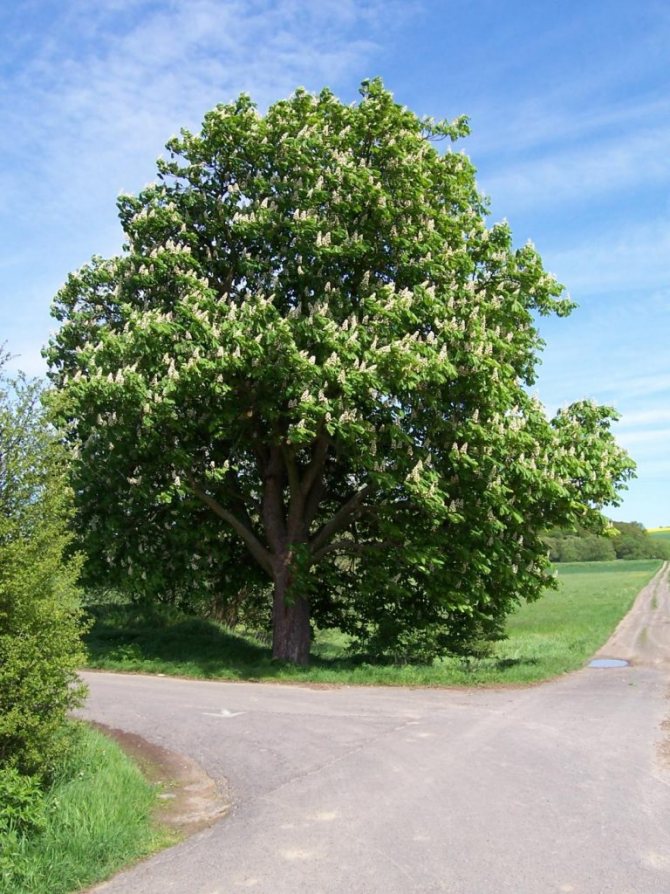

Horse chestnut grows up to 36 meters high
It grows wild in many southern countries, but it is often found in the middle lane as a garden-ornamental culture. Proper planting and caring for a chestnut tree is not as difficult as it might seem to a beginner.
Often on the Internet you can find information that the chestnut is a type of oriental plane tree, which is not true. These are completely different trees from different families. The sycamore tree has characteristic maple-like leaves, a very specific trunk and an imperceptible flowering, unlike chestnut.
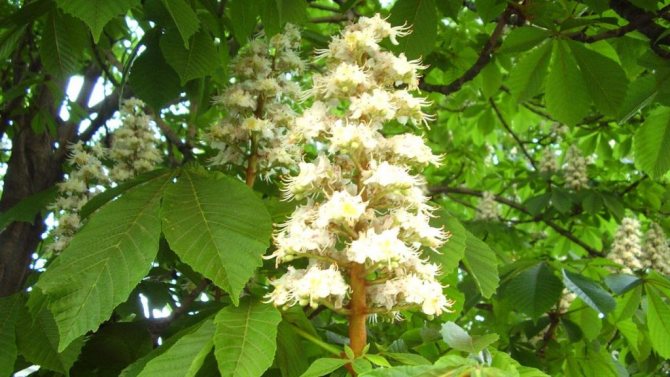

Horse chestnut flowers have beneficial properties
Having decided to plant this spreading tree in your garden, you need to take into account that for the normal development of its crown, space is needed: the distance to buildings, buildings or other green spaces should be at least 5 meters. Even grass does not grow under its dense crown, but this is an excellent protection from the scorching sun rays.
In what climate does chestnut grow
Despite its southern origin, the chestnut is quite winter-hardy. Under favorable conditions, some specimens survive for centuries.Thanks to the branched and powerful root system, the tree can grow even in rather harsh climates, requiring shelter for the winter only at a young age.
In summer, it can withstand temperatures of thirty degrees, but the best temperature for it is moderate heat of 20 to 25 ⁰C.
With good snow cover in winter, the tree survives twenty-degree frosts, but suffers from cold, piercing winds.
Chestnut also does not tolerate a gas-polluted atmosphere and dry winds. Therefore, it is often possible to observe withering and drying up foliage of trees on the streets of industrial cities in the midst of a hot summer.
Breadfruit, have you heard of this? An exotic plant that the inhabitants of Oceania first met. It is highly valuable because it can replace ordinary bread: https://klumba.guru/derevya/hlebnoe-derevo-foto-opisanie.html
What soil is preferable for him
Horse chestnut is sun-loving and drought-resistant. For him, moist, fertile loams or chernozems with a neutral or slightly acidic reaction are preferred.
The soil should be loose and well drained. It grows poorly on poor, quickly drying sandy soils.
Two sides of the same coin
It is important to know that there are both benefits and harms from an edible chestnut. Therefore, you should never abuse such a delicacy. These fried fruits are somewhat reminiscent of hazelnuts, as well as baked bread or potatoes cooked on charcoal. The composition of glossy nuts includes:
- starch;
- varieties of fats (up to 6%);
- tannins;
- vitamins of groups B and A;
- carbohydrate bonds, more than 60%;
- trace elements.
This complex is a real explosive mixture for athletes. Once in the body, nutrients release an enormous amount of energy.
The skin of the fruit contains the lion's share of fiber, so some dry the skin and then add it to food. From foliage, inflorescences and branches, tinctures, decoctions and infusions are made, which are used in the treatment of:
- inflammatory processes;
- cough;
- bleeding;
- diseases of the digestive system (has astringent properties).
Among other things, nuts cause allergies. They are contraindicated in those with kidney problems. He is recommended to use them for those suffering from low blood pressure. Among the list of what edible chestnuts are useful for, it should be noted that their inflorescences are the rarest honey plants. The honey obtained from them is very much appreciated among the inhabitants of the Caucasus.
Dried nuts can be chopped in a blender. This powder is then added to any dough. Along with the exotic flavor, you can get a decent supply of fiber for your body.
Popular varieties
The most common representative of this plant in our country is the horse chestnut. In adulthood, it grows up to 30 meters, has large, finger-like (5 or 7) compound leaves with well-defined veins. Upward-pointing racemose inflorescences appear in May. They have double white, yellow or pink flowers with red spots in the center. The fruits ripen in September - October.
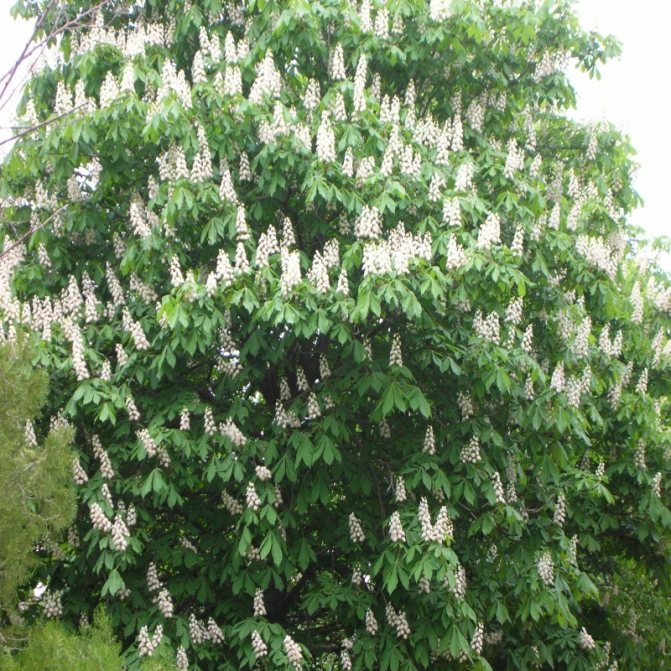

The main use of chestnut in folk medicine is the treatment of blood vessels
In addition to it, there are other types:
- Californian. It grows in the western United States, its height is up to 10 meters, and the flowers are white and pink.
- Meat red. Crimean variety with large racemose inflorescences of dark red color. The tree, which grows up to 30 meters, absolutely does not tolerate drought, loves abundant watering.
- Yellow. Eastern American variety with a pyramidal crown, yellow buds and golden toothed leaves. It is considered one of the most cold-resistant species. It blooms a little later than its congeners.
- Small-flowered. Shrub form with complex small leaves, painted on the underside in a grayish color. They grow up to 5 meters high.
- Pavia, or red chestnut. A shrub or tree native to the eastern United States. It grows up to 10 meters and is distinguished by rich red flowers and smooth fruits.
- Japanese.A tall, erect tree with very large leaves and yellow-white flowers. Its fruits are pear-shaped.
The Japanese generally have a lot of interesting plants. These include an incredibly beautiful shrub called Japanese quince or Henomeles: https://klumba.guru/derevya/ayva-yaponskaya-osobennosti-posadki-i-uhoda-foto-rasteniya.html
How to plant a chestnut tree
Planting a chestnut is a simple matter, but you should take into account the condition of the soil on the site. If the composition of the soil is unfavorable for this tree, the seat is preliminarily prepared: they dig a hole and fill it with a mixture of three parts of sod land, two parts of humus and one part of sand.
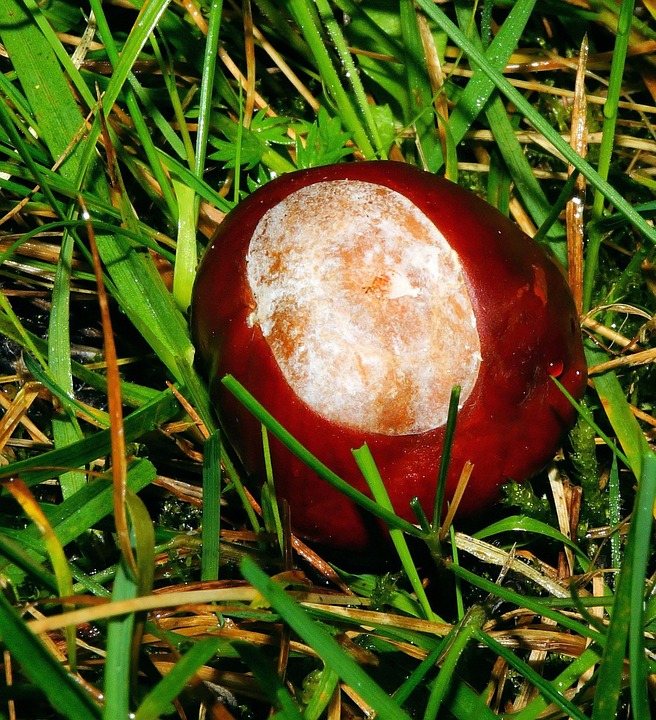

Horse chestnut fruits are a valuable raw material for the preparation of medicines
Autumn or early spring is considered the best time for planting; these dates are not recommended to be shifted, because there is a possibility that the seedling will not have time to take root.
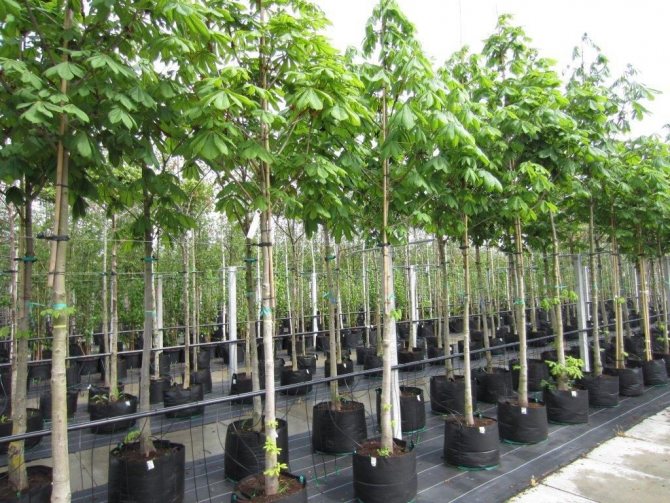

Horse chestnut is widely used in park landscapes.
Three-year-old and slightly older specimens are excellent planting material.
The order of work:
- Dig a hole more than half a meter deep and wide.
- Humus, a glass of superphosphate are introduced into the soil. An excessively acidic reaction of the soil composition is neutralized with dolomite flour.
- The roots of the chestnut tree do not tolerate waterlogging, therefore, for good drainage, the bottom of the ditch is covered with a layer of about 15 cm, consisting of sand with the addition of fine gravel.
- The root collar is placed at ground level when planting.
- To prevent subsidence of the root collar, the pit is not only densely filled with a nutritious soil mixture, but also a small mound is made around the trunk.
- Each seedling is watered with 3-4 buckets of warm water. After planting, daily watering is practiced.
- For better rooting, the seedling is tied to a support. The support can be removed when the chestnut is rooted and the tree can withstand the winds.
Seedling care in the garden
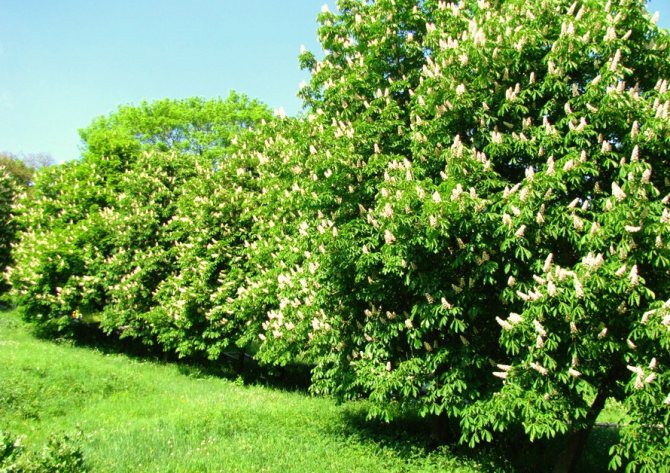

Under natural conditions, the chestnut tree prefers loose fertile soils
Caring for a tree planted in a permanent place in the garden is not difficult. At a young age, you need to constantly take care of it, while a mature tree almost does not need care.
A newly planted tree should not be left under the hot rays of the sun, it can overheat and get severe burns. When growing chestnuts in the open sun and at high air temperatures in the first year of life, you should intensively water and additionally cover the chestnut tree.
After planting, the following agrotechnical measures are carried out during the season:
- Watering. For young specimens, it should be constant, while mature ones are watered only as needed. Better to use settled water. Plants are watered at the same time - in the early morning or before sunset.
- Weeding. It is done only at first, since the overgrown dense crown of the tree does not create conditions for the appearance of extraneous vegetation in the near-trunk area.
- Mulching. To keep the ground around the chestnut loose and not dry out, it is mulched with a 10-centimeter layer of wood chips or peat with the addition of compost.
- Top dressing. Fertilization is an indispensable ritual to achieve good tree growth. After wintering, manure and urea, ammonium nitrate and phosphorus-potassium fertilizers are used for feeding. In autumn, nitroammofoska is used for this. A layer of wood chips and peat mulch is also a beneficial option for additional feeding of young trees.
- Preparing for winter. It is only needed in the first couple of years after planting. The trunk is wrapped in several layers of burlap, and the trunk circle is mulched. This prevents the bark from cracking in frost. The frost cracks that appear are treated with an antiseptic and covered with garden varnish.
- Pruning. It is necessary to stimulate a lush and beautiful crown. When pruning in spring, shoots that have grown from young trees are shortened by half.In the summer, thin twigs are removed to avoid overgrowth of the crown. Be sure to leave at least five strong side shoots intact. The places where the branches were cut are covered with garden pitch. In adult trees, only spring sanitary pruning of dry and damaged branches is done.
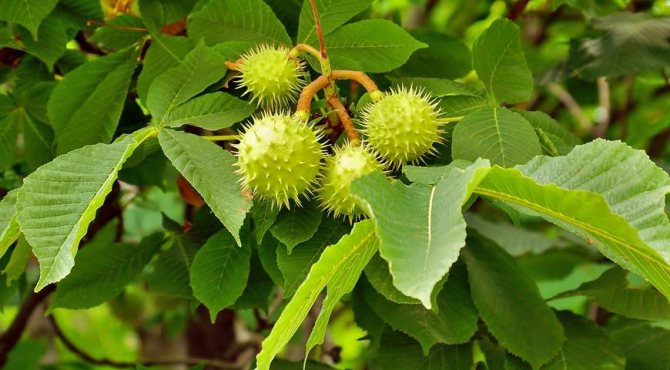

A decoction of the barbed chestnut shell is used in the treatment of gynecological diseases
Care basics
Edible chestnut does not require particularly painstaking care. The rules that a gardener need to follow can be accommodated in several points.
- Watering as needed, but no more than three times per season.
- Loosening and aeration of the soil with garden tools - immediately after watering (therefore, also no more than three times a season).
- Mulching the near-stem circle once a year. The process is carried out in the fall. Sawdust or peat is used as mulch. It is also permissible to use fallen leaves, which will serve no worse. The height of the mulch should be at least 10 cm and no more than 15 cm.
- In the name of a lush and beautiful crown, at the beginning of spring, the upper branches of the chestnut are shortened by ¼ using garden shears or pruning shears.
Fertilizer under the tree is applied only once within 12 months. To do this, mix 20 g of ammonium nitrate, a kilogram of manure, 15 g of urea and 20 g of fertilizer with potassium, nitrogen and phosphorus in a 15-liter bucket of water - and bring it under the tree.
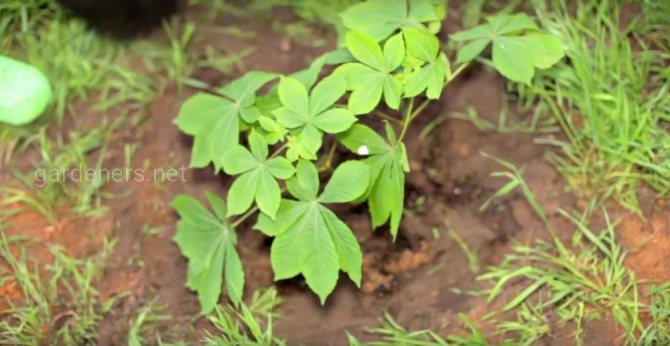

Prevention and control of diseases and pests
Although the tree, traditional for landscaping city streets, rarely gets sick, but sometimes it suffers from fungal diseases, an invasion of beetles and other pests.
A diseased tree with dry, rusty leaves should be immediately sprayed with Bordeaux liquid or Fundazol, which helps out in almost all cases.
In recent decades, previously unknown pests have begun to attack chestnut trees - the chestnut, or Balkan moth. From it, at the height of summer, the leaves dry and fall off, blooming again by autumn. Then the chestnut begins to bloom late, and because of this, it meets the winter unprepared. This leads to freezing and even death during wintering.
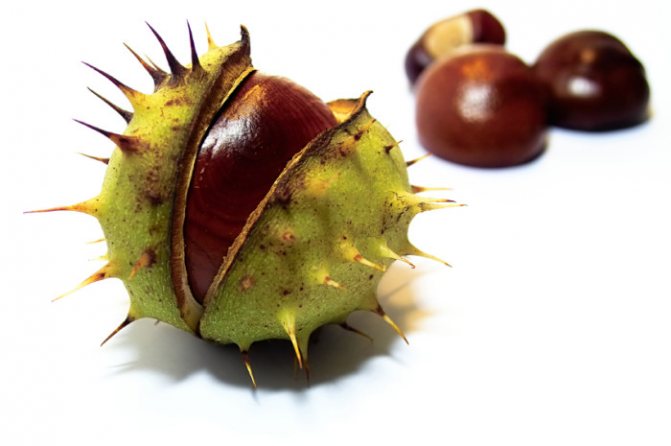

Escin, in combination with flavonoids found in chestnut fruits, prevents blood clots and strengthens the walls of blood vessels
It is difficult to deal with this pest; you have to inject a special chemical into the trunk of the affected tree. An effective preventive measure is the timely cleaning of fallen leaves, in which moth pupae prefer to spend the winter.
The tick is a dangerous enemy of the chestnut. To prevent its appearance, 2 times a month you can treat the tree with Karbofos or Fitoverm. Of the folk remedies, decoctions of dissected hogweed and black henbane are considered the most effective.
Detailed instructions for the use of Fitoverm: https://klumba.guru/uhod-za-rasteniyami/udobreniya/instrukciya-po-primeneniyu-fitoverm-otzyvy-potrebiteley.html
Which nut to choose for planting
In order to avoid mistakes in the cultivation of chestnuts, we advise you to listen to the opinion of experts and select only fallen nuts. They are used for further germination.
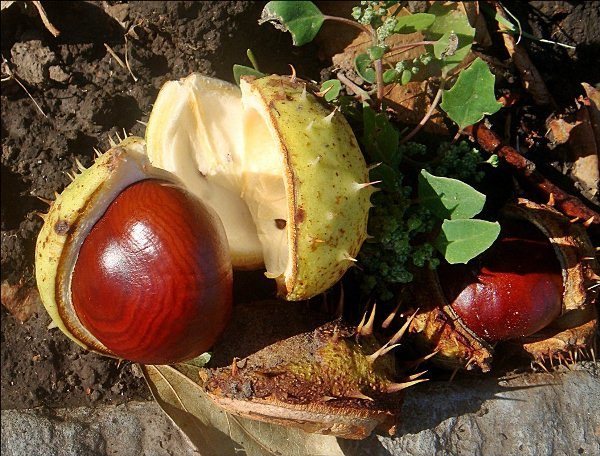

Freshly fallen chestnuts
The fruits should be smooth and beautiful in appearance, without damage or soft spots.... Select firm chestnuts for planting.
It is better to start planting in the fall, after harvesting the fruits. It is not always possible to save nuts until spring without losses. They dry out and lose their germination... If this is not possible, then store the chestnuts until spring in a bag of wet sand.
Problems arising in the cultivation of chestnut, and their solution
Growing chestnut trees is usually little hassle. But sometimes you have to face some complications:
- Leaf spot. It is perforated, black, brown or reddish brown. With this phenomenon, it is important to collect all the affected leaves and burn them. A diseased tree needs extra feeding, a decrease in the frequency of watering.Its additional protection will be a cover with a film tied to several pegs.
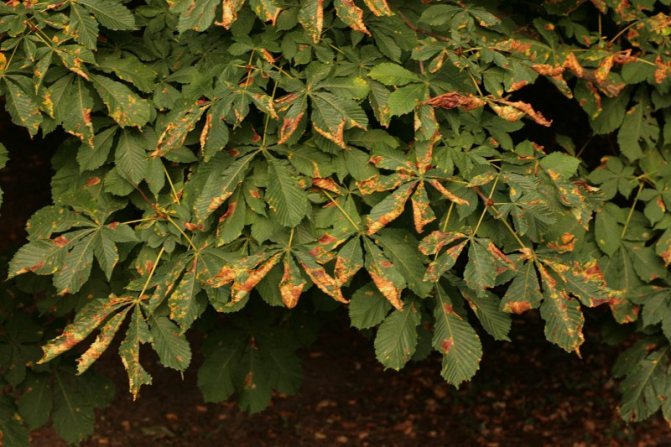

Spotted tree weakens and blooms poorly
- Powdery mildew may appear on the tree due to excessive heat or oversaturation with nitrogen against the background of a deficiency of phosphorus and potassium. In this case, treatments are carried out with Topsin, Fundazol or Fitosporin-m.
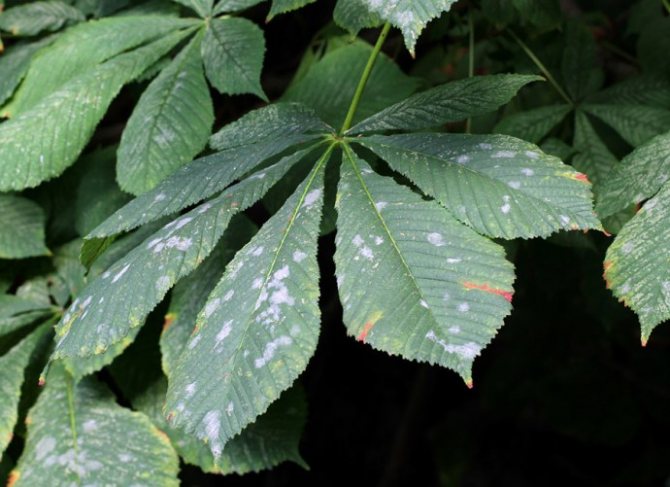

Powdery mildew looks like a gray-white coating on the leaves.
- Necrosis. Its causes may be temperature drops or mechanical damage to the plant. This problem is especially terrible for young specimens. The place of damage is cut out, the wounds are disinfected and covered with garden varnish. A measure of prevention of such a painful phenomenon for a tree is to whitewash its trunk in spring and autumn.
- Rot on the bark is a serious problem, from which there is no escape. When it appears, the chestnut is cut down and burned. Preventive methods: liming the soil and spraying the plant with systemic fungicides.
Germinating seeds
In order for the seeds to germinate, stratification is required - they must be kept at a low temperature for several months. This can be done in natural conditions. Then the procedure comes down to planting chestnuts in the fall in open ground, which will need to be covered with a layer of mulch. Alternatively, you can immerse them under the snow cover. But in both cases, the possibility of damage to seeds by rodents cannot be ruled out.
Therefore, it is better to give preference to artificial stratification. This method has several advantages:
- the percentage of germination increases to 95%;
- seedlings develop faster;
- strong seedlings are formed by the end of May;
- plants of the first year of life are quite ready for winter frosts.
After collecting the seeds, until the onset of cold weather, they are stored in a fabric bag in a cool place, for example, on the balcony. When the outside temperature drops to freezing, the chestnuts are loaded into a container with a lid, filled with slightly damp sand and closed. Packaged seed should be stored in a basement or refrigerator for 2-5 months. The temperature here should not drop below + 5º.
About a week before planting, the nuts are removed from the sand and immersed in a container with heated water for 5-7 days. The fluid is changed periodically. Soaking will soften the dense chestnut rind and increase the chance of nut sprouting.
The chestnuts can then be planted in pots. Any loose soil is suitable for this (it can be mixed halfway with sand). The nuts are sealed to a depth of about 5 cm, after which they are watered and placed on the windowsill. The earth is moistened as it dries. The first shoots usually appear in 2-3 weeks, but sometimes you have to wait about two months. Therefore, if the plant is planned to be planted in the yard this spring, then germination should be started at the end of February, not later.
Planting chestnuts in the garden in autumn is carried out in September - October. Immediately after collecting ripe fruits, they are planted in loosened ground at a distance of 20 cm from each other. The recommended planting depth is 5 cm. If you bury them deeper, they may not ascend. More shallow immersion can cause drying or freezing of seeds. The beds are leveled and watered, then insulated with fallen leaves, sawdust or straw. At this, the germination work can be considered completed. Seedlings will appear in the spring.
But you don't have to bother at all. There must be a chestnut alley somewhere nearby. Under mature trees, it is easy to find young growth. It is she who can be used as a "seedling". It will be enough to carefully dig up a young tree and transfer it to the desired location.
Seed propagation
The forums discuss the cultivation of chestnuts from nuts. This is a challenging, but accessible and educational method of getting a new tree in your garden.
When growing seedlings from nuts, to increase the effectiveness of the event, at least 5-10 pieces must be planted at the same time.There is always the possibility of planting unripe or damaged nuts that will not sprout normally.
To protect a young tree from insects, it is prophylactically treated with antiparasitic drugs.
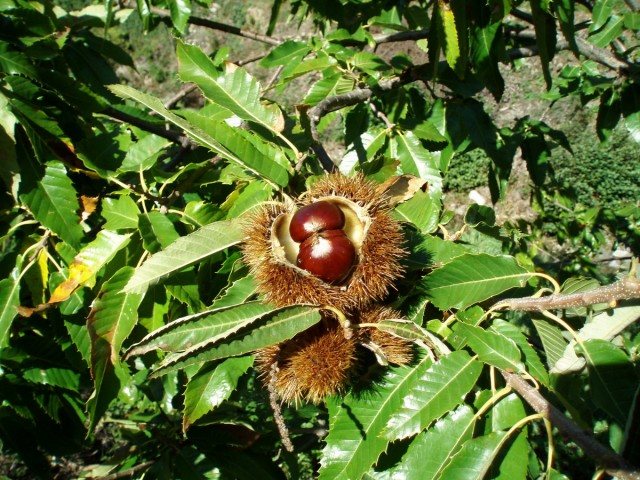

A valuable feature of the sowing chestnut is its edible fruit
The most interesting tips are:
- Nuts are planted in flower beds, for example, next to tulips. At the same time, dry grass is laid in the grooves in several layers, and covered with earth on top.
- Spraying with Fufanon helps to save young twigs from aphids.
- From mice, it is effective to lubricate nuts before lowering them into the ground with a clay mash with the addition of red pepper, tar or kerosene. Then you can sprinkle kerosene on the soil at the planting site.
- For better growth, young shoots should be treated with Mycorrhiza, Trichodermin or Fitosporin on a monthly basis. This is additional nutrition and protection of plants from various pests and infections.
- When planting chestnuts with seeds, it is better to immediately choose a permanent place for them. This prevents damage to the root system during subsequent transplantation and thereby increases their resistance during unfavorable wintering.
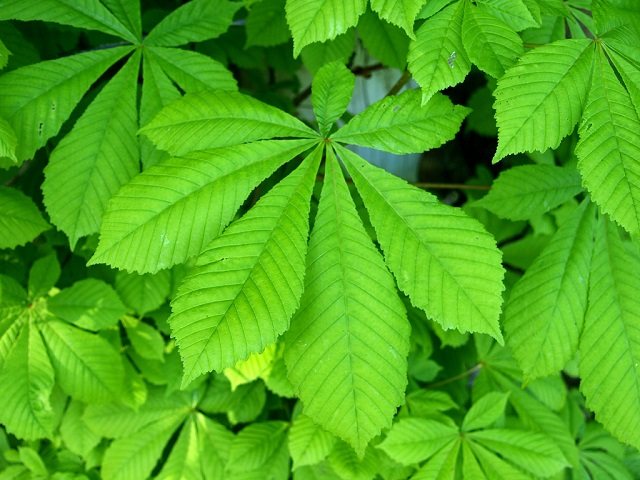

For medicinal use, horse chestnut leaves are harvested when they are green and juicy.
Gardeners reviews
I advise you to transplant chestnuts in early autumn, when the heat has already subsided, but it will still be warm enough. Transplant with a clod of earth (if before that there was a heat and the earth is crumbling, water it a couple of days before transplanting so that the earth "grabs" and a clod of earth around the roots holds). Be sure to spill well after transplanting. And a week later again. You can water with Kornevin when planting. I do not recommend trimming the central stem. Chestnut is not a bush, it should have one trunk. It is by nature laid down to be even)
I have a horse chestnut growing. He is already 5 years old. It grew 1 m from a nut that I planted for testing (it grows - it will not grow). He is very attractive even without flowers (the sun is not enough for him). It grows in front of the dacha, along the path. I expect that someday he will give a shadow on the house and on the car, near which he now found himself (when I was planting, I did not think about the car).
Many gardening enthusiasts have tried to grow horse chestnut in Siberia, but these attempts have led to nothing. The trees, despite their growth and even fully matured shoots by the fall, froze over the winter. Or completely frozen out. As well as attempts to grow a seedling from a nut. Such seedlings grow and hibernate while small, after, when their growth increases, they freeze slightly and become like a bush.
We did this. In the fall, they simply planted the chestnuts in a row. At a distance of about 50 cm from each other, half a bayonet. If the soil is dry, pour water into the hole before planting. To plant in the fall, they need to survive the cold. That's all. In the spring, out of 9 planted chestnuts, 7 have risen. Watered and loosened. A year later, 2 seedlings were planted near the yard, the rest were distributed.
When growing a horse chestnut tree or its varieties, you need to be patient, it does not grow quickly. With careful care, after a dozen years, having significantly outstripped all the surrounding garden trees in growth, it will become protection from the summer heat thanks to its dense, juicy and delicate foliage. If necessary, this plant can also become a healer for many diseases.
The choice of planting material
It should be noted right away that you need to engage in the cultivation of horse chestnut. Its edible varieties do not differ in winter hardiness and are suitable for planting in our country except in the Caucasus and in the south of Ukraine. And even if it turns out to grow such a sample, its fruits are likely to be tasteless, and the tree will need to be grafted.
Chestnut seedlings can be easily obtained from seeds. But for this, you should choose the right seed. It is important that he meets the following criteria:
- maturity - the fruits should not only fall from the tree themselves, but also have a burst prickly casing;
- no damage;
- dark, even color;
- hardness;
- lack of rot.
For germination, you need to take more nuts than you plan to get seedlings. Some may not sprout. In addition, immature plants, for various reasons, often die at the early stages of development. Chestnuts are usually planted from seeds in the fall, shortly after picking nuts. This is due to the fact that under normal conditions the planting material is poorly stored and may lose germination during the winter.
If, nevertheless, germination must be postponed until spring, then the fruits should be stored in a box with moistened sand. This will prevent the chestnuts from drying out prematurely.

